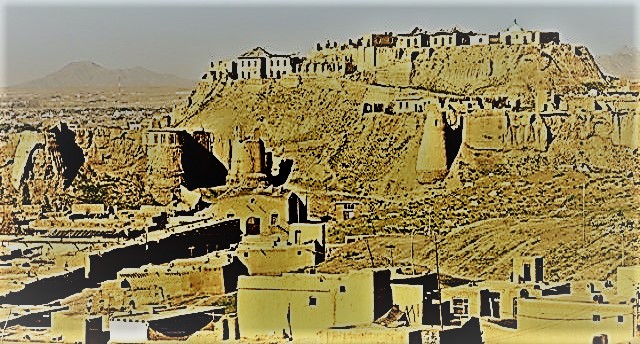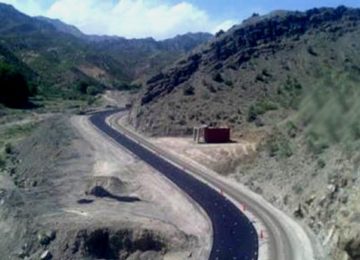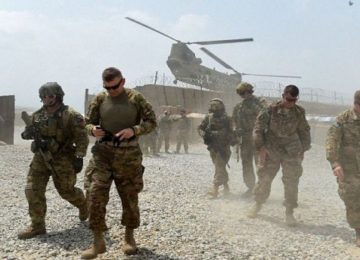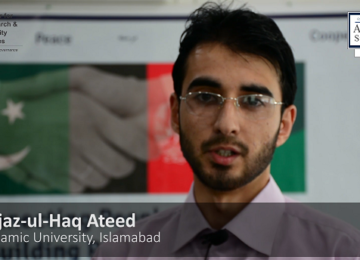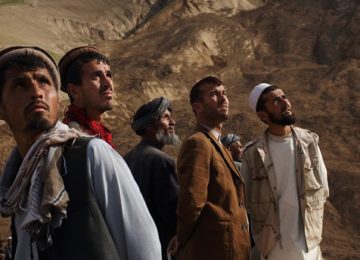Ghazni is one province where the Taleban have long-established significant influence. Actually, they dominate it militarily, with the exception of the provincial capital, all but one of the 18 district centres and some larger areas in three districts. Over the spring of 2018, the Taleban – although not capturing more territory –, have significantly expanded their threat to so far secure districts and other areas. AAN’s Ehsan Qaane looks at the reasons and assessed the overall security situation of Ghazni with its significant shifts in this last spring.
Spring 2018 ended with three days of a genuine ceasefire between Afghan government and the Taleban forces. From 15 to 17 June, over the Islamic festival of Eid al-Fitr, the two sides’ independent and different long truces overlapped. Over the three Eid days, Ghazni city hosted dozens of Taleban militants who entered the city to celebrate the holiday with their families. They freely walked in public places and fraternised with members of Afghan National Security Forces (ANSF) (AAN reporting here).
This was a positive, but short exception from their usual behaviour. Before the ceasefire, the Taleban had carried out a whole series of large attacks in 14 of the 18 districts of the province and in villages nearby its capital. The attacks started on 12 April 2018 in the district centre of Khwaja Omari. Apart from this, Muqur, Jaghatu, Andar, Deh Yak, Ajrestan, Gilan, Waghaz, Khugyani, Ab Band, Giro, Qarabagh and Rashidan, as well as the villages of Spandi, Shahbaz, Qala-ye Qazi and Arzo that belong to the provincial capital’s district, were also assaulted. The New York Times reported in May “the central government in Kabul expressed fear that the Taliban had made it a priority to overrun Ghazni [city].”
Taleban attacks on Afghan National Security Forces (ANSF) checkpoints or district centres are not new with a long list of attacks with a growing number in 2017. In September 2014, the Taleban almost captured of Ajrestan (a media report here and AAN reporting here), which is far from the provincial capital and badly staffed. In 2017, there were near falls of Waghaz, Giro and Gilan; a series of attacks in Deh Yak in the same year and various sieges of Andar, just outside Ghazni city, the last time in autumn 2017; see also AAN reporting about the failure of local uprising forces here).
This year the Taleban, for the first time in 17 years, managed to seize centres of relatively safe districts close to the provincial capital. This occurred in Khwaja Omari and Jaghatu on 12 April and 21 May 2018. In both cases, the Taleban left these centres within hours following their capture. This retreat was without any further clashes with the ANSF so as to keep their casualty figures low.
On 3 May, they also blocked the Ghazni-Paktika highway to civilian and military traffic for more than two months. This was a unique development since the Taleban’s re-emerged as an insurgent group in south-eastern Afghanistan. This highway is crucial for Ghazni’s defence, as it connects the city to the base of the Tandar Corps, the Afghan National Army Corps 203 based in Gardez in Paktia, further east of Paktika. This corps is the command centre of the Afghan National Army for south-eastern Afghanistan, ie the three provinces of Loya Paktia, Logar and Ghazni.
In addition to their attacks, the Taleban have created problems for the residents of Ghazni city by carrying out assassinations and collecting taxes. The residents of the three secure districts, particularly Jaghori, have suffered after mines were planted and temporary checkpoints were erected on the roads that connect them to Ghazni city. Previously, the Taleban occasionally had blocked this road and the Kabul-Ghazni highway, but only for a few hours each time.
In April and May 2018 alone, the Taleban killed at least four high-ranking local officials, including Ali Dost Shams, the district governor of Khwaja Omari, Faiz Muhammad Tufan, the chief of police of Deh Yak, Haji Barakatullah Rasuli, the commander of the reserve police unit of Ghazni province and Baryalai Rezai, the district head of the National Directorate of Security (NDS) of Khwaja Omari.
It looks as though the Taleban new military strategy for Ghazni is to expand their threat to secure districts, while the closure of the Ghazni-Paktika highway is a further step to put pressure on the provincial capital.
The Taleban’s Ghazni surge
The new surge of insecurity in Ghazni started at the beginning of 2015. This followed the withdrawal by mid-2013, first of the Polish troops who had provided the majority of the local Provincial Reconstruction Team (PRT), and then, by the end of 2014, also the US troops. This left the war against the Taleban in this large, multi-ethnic province – the population of which has been estimated at 1.3 million in 2018 by the Afghan Central Statistic Organization; more data here) – on the shoulders of the ANSF. However, the ANSF’s tashkil(number of personnel allocated) has been too small to cope, at least in the eyes of local officials. The current tashkil for Ghazni is 2,500 ANP and 4,200 ANA, according to provincial council member Hamidullah, talking to AAN. This has opened space for the Taleban since to expand their territory and power in the province.
Currently, a number of US troops have returned to the provinces, according to provincial officials quoted in Afghan media. However, their number – as with the overall number of extra troops sent to Afghanistan under the Trump strategy – has not been made public.
Even by 2015, the Taleban controlled more of Ghazni province than the Afghan government (see this map). This equation has since further changed in their favour. This trend did not continue in 2018 but, as the result of their spring offensive, the local the government’s grip on the so far relatively secure areas, such as Jaghatu and Khwaja Omari has become shaky. Since April 2018, control over some of their areas, including their centres, has changed hands between the ANSF and the Taleban – Jaghatu twice and Khwaja Omari once. Across the province, the government currently only controls the city of Ghazni, the three Hazara-dominated districts of Nawur, Malestan and Jaghori, and the district centres of the remaining districts, except Nawa where, exceptfor one week in May 2015, had been under Taleban control ever since 2001.
Case studies of some significant attacks
- Muqur: mining gold
At midnight of 12 June 2018, the Taleban’s Red Unit (Pashto: Sra Qeta, read more about it in this AAN analysis) attacked the headquarters of the district governor of Muqur. Muqur is located on the Ghazni-Kandahar highway and contain Zarkashan gold mine, one of the biggest gold mines in the country. They began their assault by detonating a Humvee full of explosive material at the main entrance of the compound and then entered into the building. As the result, Afghan media reported, five ANSF members were killed and 25 others, including the district governor, Habibullah Muquri, and head of NDS unit in Muqur, injured (see here and here; these reports do not mention the Red Unit, this information comes from a local journalist). However, the Taleban failed to seize the whole building and withdrew from the area in the morning.
This attack occurred on the first day of the government’s unilateral nine days truce. Presumably, the Taleban had apparently hoped to find the ANSF with their guard down (AAN reports about the ceasefire here and here).
On 7 February 2018, a group of Muqur residents, including some from Zarkashan, came to Ghazni city and complained that the Taleban were mining in Zarkashan with the support of Pakistani engineers and that the government was not preventing this from happening, as Afghan media reported. The report quoted a protester and an elder from Muqur, who said, “if the Taleban did not attack the district centre of Muqur so far, it was because of the mining.”
- The temporary capture of Jaghatu and Deh Yak
On 21 May 2018, the Taleban captured Gul Bawri, the district centre of Jaghatu, and Deh Yak’s district centre, which has the same name as the district. (Notice that two districts are named Jaghatu: one in Ghazni, one in Maidan Wardak province; both have a joint border.) They killed the district chief of police of Deh Yak, together with five other ANSF members. The Taleban also burned down the district governor’s office, as Nasir Ahmad Faqiri, a member of the Ghazni provincial council, told AAN on 23 May.
Another member of Ghazni provincial council, Hamidullah Nawruz, told AAN on 22 May 2018 that Gul Bawri was seized by the Taleban even twice in one week. The first time was 16 May. Both times, the Taleban assaulted at midnight, using night-vision equipment and heavy weapons, and captured the police district headquarters. During the first attack, the Taleban cut off the road that connects Gul Bawri and Ghazni city by planting mines to prevent government support forces reaching the town. According to him, these reinforcements, including from Unit 333, an elite unit of the national police, Afghan National Army (ANA) commandos and regular ANA forces only arrived at the district centre at 9am, after the Taleban had left the area. Yasin Joya, the district governor of Jaghatu, in an interview with AAN on 20 May, stated that the Taleban are provided with safe haven in the villages of Zamankhel, Safarkhel and Mirokhel, which are only one kilometre distant from Gul Bawri, in Khugyani district. According to him, Khugyani, and Waghaz districts – Pashtun majority areas – as well as mixed Tajik-Pashtun Rashidan, were split from the mixed Hazara-Pashtun Jaghatu as new administrative units during the mujahedin and Taleban eras. As Gul Bawri was the district centre of the former ‘greater Jaghatu’, as Joya called it, after the division, it found itself located at the border of these insecure districts, whilst their Taleban dominance made it particularly vulnerable. He said it would better to shift the district police office to Sarab, where the district governor’s office had already been moved three years ago, and name Sarab as the new district centre for Jaghatu. He added that moving of the district governor’s office to Sarab had not been decided upon due to insecurity, but rather to bad communication: “It was difficult for locals to travel to Gul Bawri as it is located in a [distant] corner of the district.”
When the Taleban attacked Jaghatu district centre for the second time, the reinforcements were already present there. However, they withdrew after heavy fighting with the Taleban, Faqiri told AAN on 23 May.
- Ajrestan, isolated and deserted
On 20 May 2018, the Taleban took two key villages of this remote district at the border with equally unruly Uruzgan. In Muhammadkhel, where district governor, Hamdullah Hasibzai, was living and working, and Adrakey, where the district chief of police, Obaidullah was working and living, they looted all houses – both villages are outside the district centre, but not far away. Only by the ANA military base that the Taleban have failed to capture uses the official premises of the district governor in the district centre.
“The attack was started on 17 May 2018 by the local Taleban together with Taleban militants from Uruzgan, Helmand and Kandahar,” Hasibzai told AAN on 16 July 2018. After the Taleban took all the local check-points; three on the second day of their attack, two on the third day and the last one on the fourth day, all civilian government and military personnel – except the ANA in the nominal district centre further away – escaped to Mir Amur district in neighbouring Daikundi; 105 people in total, including 50 ANA soldiers, the district governor and the district chief of police. On their way, they were ambushed again. As a result, five of them were injured and 22 others, including five civilians, captured by the Taleban. The Taleban later released the civilians, but kept the 17 ANSF personnel. All who managed to escape, including the district chief of police and the district governor, are living in Ghazni city now. Around 50 families of Afghan National Police and Afghan Local Police also came and joined their men. The Taleban sent a message to the Ajrestan personnel saying, “if you want to live, don’t return to your homes.”
Hasibzai told AAN that he resigned from his position because working in Ajrestan without the full support from the government was “suicide.” He added that all four roads connecting it to its neighbouring districts – to Malestan and Nawur in Ghazni, Mir Amur in Daikundi and Khas Uruzgan in Uruzgan – were closed by the Taleban to government employees ever since the Taleban re-emerged in the area again years ago. As a result, military supplies are impossible to bring in by road. He added that, over the last 15 years, the government employees were only able to travel to and from the Ghazni city, 200 kilometers away, by air. According to Hasibzai, the Taleban now control almost 90 per cent of Ajrestan.
Compared to the attacks on Khawja Omari, Jaghatu and Deh Yak, this was the heaviest attack of this last spring. Lasting three days, it constitutes an exception to the strategy of ‘quick assault and withdraw’ usually employed at other places. This approach is favoured given the extreme isolation of Ajrestan district. The conflicting reports whether (by the Taleban) or not (by the government) the district centre was taken during this attack relate to the fact that the district centre proper, with the ANA base, was not taken, but the two resident villages of the district governor and police chief, which function as the de facto district centre.
- Khawja Omari, safe so far
On 13 April, the Taleban attacked the district centre of Khwaja Omari, only 16 kilometers to the north of Ghazni city. Thus far, it had been one of the relatively safest districts of the province. The Taleban killed the district governor, Ali Dost Shams, and 20 ANSF members, including the head of National Directorate of Security (NDS) for the district, Baryalai Rezai, son of a mixed Hazara-Pashtun family native to Khawja Omari.
On 16 May, AAN interviewed a commander of Afghan Local Police (ALP) who was there on the night of assault (he requested AAN not to be named). According to him, the attacks started around 1am from two directions in the same time. One group attacked the checkpoints close to the district police HQ and the other group attacked the residence of the district governor. Within one and a half hours, the Taleban seized the control of the district centre. He added: “Only we – eight members of ANSF – remained in the building of district police HQ and resisted.”
The Taleban stayed in the district centre for two hours only and left the area before sunrise when support forces from the provincial centre arrived.” The ALP commander told AAN that a small group of forces headed from Ghazni city to Khwaja Omari soon after the attack started. However, they first had to return to the city after they hit mines at the Ziarat-e Kushk area, six kilometers outside Ghazni city. As the result, one of their Humvees was destroyed and eight of their personnel killed or injured. He added: “Until 9am no more support forces arrived on the ground.”.
The ALP commander told AAN that the Taleban in Khwaja Omari also used night-vision goggles. He gave an example to prove his claim: “When eight policemen left the district police HQ to support the governor, four of them were shot immediately at the gate. Each of them was killed only by one bullet in the head.” Referring to the intelligent reports, he told AAN that 120 Taleban militants from Paktia, Logar and Maidan Wardak provinces participated in the attack. Before the attack, they had gathered in Jaghatu district of Maidan Wardak, which shares a border with Khawja Omari. He also said that Jaghatu’s local Taleban were not involved in this onslaught. It can only be speculated why this was the case: as their numbers are relatively small, they might have been afraid of the revenge from those attacked.
Media reported that 59 of the Taleban attackers were killed by an airstrike in the same morning of 13 April in Maidan-Wardak’s Jaghatu where they celebrated their victory.
- Attacks on the security belt of Ghazni city
On 21 May 2018, the Taleban raided ANSF checkpoints in villages that are administratively part of the provincial capital, Spandi and Shahbaz. They also ambushed Haji Barakatullah Rasuli, the commander of the reserve police of Ghazni in Spandi. Rasuli and his four bodyguards were killed.
Ghazni city has been partially under Taleban siege to the west and south since 2015. It also has been the target of a series of spectacular attacks. In 2014, the Taleban blew up the local NDS office and other installations with a massive truck bomb, in September 2015, when their fighters broke into Ghazni provincial jail and freed 355 prisoners, including high-ranking commanders, they also captured the NDS office and obtained important files (AAN’s report on breaking jail here) and, in 2016, when they stormed the Ghazni courthouse.
Qala-ye Qazi, located two kilometres to the west of Ghazni city, and Spandi, four kilometres to the south, demarcates the frontline between the government and them. Mangur village, some seven kilometers to the south of Ghazni city, is the centre for the Taleban, who are in charge of the city and its surrounding rural areas, which together are one administrative unit. According to a local journalist (who talked with AAN on condition he was not named), Hanafi Muhammadi, the head of Taleban’s military commission for Ghazni’s provincial capital, and Mullah Shams Wadood, who is in charge of collecting ushr(Islamic tax) there, are living in this village. In early May 2018, the New York Times reported how the Taleban systematically collect taxes in Ghazni city and were openly living in some parts of it, quoting a senior police officer as saying “They have their homes here and can do whatever they want to.”
Wahidullah, the local journalist confirmed this to AAN. According to him, Taleban have issued death threats to Ghazni residents, including the local media, if they do not pay taxes to them. For their safety, the residents obey the Taleban. Hamidullah Nawruz, a member of the Ghazni Provincial Council, told AAN the Taleban collect ushr from residents of Ghazni city and in all places they have control over. In the city, they contact the wakil guzar (neighborhood representative) and representatives of professional associations, asking them to collect specific amounts from the residents or members of their guzaror associations on behalf of the Taleban and to hand it over to the representatives of the Taleban’s economy commission. The venue for handing it over, which is usually in Mangur village, is set via the phone.
Nawruz also told AAN on 16 July 2018 “seven months ago, my colleagues and I did a rough estimation based on documents we obtained. We found that the Taleban’s revenue from tax collection is around 25 million Afghanis per year only in Ghazni province.”
In addition to this, the neighbouring district of Ghazni city, including Deh Yak, Zana Khan, Khugyani, Waghaz and Andar districts, are almost fully controlled by the Taleban. From there, they can launch attacks and assassinations, and easily retreat back afterwards. Only in April 2018, nine people were reportedly assassinated in Ghazni city. (There were 18 in 2017, according to Afghan 1TV (source BBC monitoring, 10 November 2017).) The assassins use ordinary pistols with silencers and, after their assaults, escaped riding motorbikes out of the city. Local officials said that they arrested five people accused of involvment in these assassinations. Wahidullah, the local journalist, told AAN on 12 July, though assassinations have declined after the Eid ceasefire, the previous incidents have poisoned the atmosphere and people are really scared.
Hasht-e Sobh (8am), an Afghan daily newspaper, quoted Aref Nuri, the spokesman of the Ghazni provincial governor admitting that the local officials knew about the Taleban tax collection, but, apparently, they cannot do much about it. Instead, as Nuri said in this interview, they arrested two people for paying tax to the Taleban. Noori added that these two people were released after elders intervened on their behalf.”
What messages do these attacks convey?
- Tactical issues
Almost all these attacks occurred during the night. According to local sources, the Taleban used night-vision equipmentand sniper rifles, while the ANP and ALP, who tried to beat back these attacks, do not possess such technology. According to an ALP commander in Khwaja Omari, the members of ANSF have two options to face this problem: stay in their check-points to be killed from short range or escape and be shot while doing so over a longer distance. Aref Rahmani, an MP from Ghazni, in his interview with AAN on 14 June 2018, criticised the National Unity Government (NUG) and said, despite ALP and ANP guarding parts of the country which are insecure or bordering Taleban territory, it has not provided them with heavy and modern weapons. He believes that, because the ALP and ANP have lighter weapons and less personnel than the Taleban, their casualty figures are higher in comparison to the ANA. (Although the ANA, and particularly their commandos and the Air Force, are also involved in combatting the Taleban, most of the brunt of this fight is borne by the police and auxiliary police forces.)
There are also communication problems. During the night, most high-ranking officials switch off their phones, so that it is harder to contact them in the provincial centre or in Kabul for help. For example, when the Taleban attacked Khwaja Omari disctrict centre, the district governor was only able to contact the deputy governor of Ghazni, Aref Wahidi. According to Shams’ brother, the cell phone of the provincial governor, Abdul Karim Matin, was out of the coverage area and the cell phone of the provincial chief of police, Mohammad Zaman, was switched off. The Taleban, of course, understand this. Furthermore, the ANSF limit their patrols in the evenings. In addition, the Taleban plant mines along the routes that reinforcements have to take to get to the target areas.
As a result, their night assault tactic gives them two advantages: better vision and fewer threats by reinforcements.
- Threatening or conquering?
These assaults on districts centres and Ghazni’s suburban villages also indicate that the Taleban are looking to increase their pressure on the areas in Ghazni province still under government control, rather than to necessarily expand their territory in Ghazni. Although they are theoretically able to easily gain control of at least the centres of Andar, Giro and Ab Band, where their presence is the strongest and where they easily can bring in reinforcements from neighbouring Paktika and Paktia, they still prefer to carry out sudden attacks, followed by quickly withdraw. They also used this tactic in their attacks on Khawja Omari and Jaghatu on 13 April and 22 May. While avoiding casualties for themselves (and the local population) from counter air strikes, this allows the Taleban to keep the initiative, while the – often outnumbered and qualitatively outgunned – government forces remain on the defensive. It also inflicts more casualties on the ANSF. In addition, the Taleban benefit from the situation that the government has to supply its forces in often besieged district centres with weapons and ammunition by breaking through their siege. This inevitably allows some supplies to fall into their hands. Also, their attacks on ANSF checkpoints provide them with extra hardware.
The Taleban attacks on Khwaja Omari and Ajrestan revealed that the Taleban gather militants from neighbouring locations for these assaults. This needs pre-planning. The fact that the attacks happened means, the Afghan (and other) intelligence services were unable to discover them in advance, or there were simply insufficient forces available to send to help the defenders. On the other hand, collectively, such attacks make sure the local ANSF are outnumbered and ensure relatively easy, if only temporary, victories for the Taleban. The ALP commander from Khwaja Omari told AAN that the Taleban who attacked on Khwaja Omari were 120 armed men, while ANSF were only 28-30. The Taleban used this advantage and defeated ANSF. Attacking, briefly capturing and then withdrawing are classical guerrilla-style pin prick operations to force the more static enemy to be constantly on the watch and to shift around its best forces too often (see this AAN analysis).
The Taleban’s attacks also reveal that they are able to strike in various districts at the same time. For example, when they attacked Jaghatu (the first and second time) and Ajrestan, they also assaulted Giro, Andar, Deh Yak, Waghaz, Rashidan and Khugyani districts, as well as the security belt around Ghazni city, in order to split the ANSF and hide their main target areas. This is a tactic the Taleban had already employed in 2014 when they attacked the local NDS office and other installations.
- Government shortcomings
On 22 May 2018, while the district centre of Ajrestan was being besieged and the district centres of Jaghatu and Deh Yak captured by the Taleban, President Ashraf Ghani held an emergency meeting in Kabul. He talked via video call with Ghazni provincial governor, Abdul Karim Matin (he dismissed him from his position some days later), and Sho’ur Gul, the commander of Tandar Corps. According to the president’s website both officials gave a report about the Ghazni security situation and the problems there. In response, as it was put on the website, “the President ordered them to prioritise their works and to do comprehensive efforts.”
Although the website does not give more details on what the president exactly meant, Ghazni MPs have usually criticised local officials in the province for their lack of cooperation and gaps in their war strategy. For example, Aref Rahmani mentioned to AAN on 14 June 2018 the lack of cooperation among the civilian and the military leadership of Ghazni as one of the main gaps in fighting the Taleban in that province. This point was illustrated by Hamidullah, a member of the Ghazni Provincial Council, who told AAN on 15 July that the provincial chief of police usually took orders directly from Kabul, and not from the provincial governor. He said this is “a bad practice in Ghazni regardless who the provincial governor or provincial chief of police is.” (This is a problem in the other provinces, too.) Therefore, he was pessimistic that Ghani’s changes to the province’s leadership would alter the situation, as it does not integrate the chain of command.
The NUG has renewed the civil and military leadership of Ghazni various times in May, June and July 2018. On 12 May, after the Taleban attack on Khwaja Omari, Muhammad Zaman was dismissed and Farid Mashal appointed in his place as the provincial chief of police. Instead of Abdul Karim Matin, Wahidullah Kalimzai, originally from Wardak province and former provincial governor of Kunar, was appointed as provincial governor on 2 June. Finally, on 9 July, Muhammad Amin Mobalegh, former deputy to the provincial governor of Wardak, was made deputy provincial governor.
In the emergency meeting, President Ghani also ordered the related institutions “to provide resources of a first-grade province [to Ghazni] as it is a first-grade province”. (Afghanistan’s provinces are divided into three categories, according to their population.) So far, Ghazni has received resources only as a third-grade province with military personnel, leading – among other issues – to the above-mentioned current ANSF tashkil of 6,700 ANP and ANA. This allows the government forces to retake lost territory, but they are insufficient to hold it permanently. When, in May 2015, ANSF recaptured Nawa, it failed to keep it safe for more than one week. Ghazni centre did not have enough personnel to deploy there, so the ANA had to leave again. Similarily, Hamdullah Hasibzai, the former district governor of Ajrestan, told AAN on 15 July 2018, that, although Afghan commando and ANA are in the district centre of Ajrestan since 22 May 2018, they have not ventured to retake those villages the Taleban have taken in May. He argued also that there the number of local security personnel is too low to safeguard the villages after a withdrawal of the ANA and Afghan commandos.
These are obviously meaningless expenditures of human and financial resources without any long-term security impact. This explains why the ANSF remains on the defensive in Ghazni – and probably in many parts of the country.
Conclusion
Although Ghazni city and some districts are considered part of government-controlled territory, the Taleban are exercising sovereignty by collecting taxes there. It looks as if the government cannot stop the Taleban.Its resources seem too weak, and there are grave shortcomings in coordination and general governance.
The Taleban may not want, or may be unable, to extend their territorial grip in Ghazni in the near future. Already, they have control over those parts of the province where they can recruit militants among the locals most easily. This is mainly in the Pashtun areas (although not all locals support them). The Hazara majority areas – often isolated from the Ring Road – are under pressure by the Taleban dominance and their frequently closing the roads connecting them with Ghazni city. Therefore, the Taleban occasionally are able to coerce local communities into mutual non-aggression deals.
In the current situation, the Taleban would only be able to capture the remaining parts of Ghazni, including Ghazni city,if at all, for a short time. The Taleban do not have much local support in the three Hazara districts and in Hazara-dominated areas in mixed ones, such as Jaghatu, Khwaja Omari and Qarabagh. In Ghazni city, the government is still much stronger than the Taleban, despite the Taleban’s ability to threaten and pressure its residents by assassinations and taxation. The Taleban presence in districts nearby, however, keeps up a serious threat for Ghazni’s centre and its residents. Militarily, the initiative remains on their side, while the government forces often only can react.
Due to this constellation of factors, the areas under Taleban control even appear more secure when compared to those in government-controlled territory. The local populations in the territory of the Taleban may not be happy with their rule, but at least they enjoy a degree of security. It looks like the situation favours the Taleban, until such time that the government can increase its military personnel (which seems to be the case with the expansion of the ANA ‘territorial’ forces, see AAN analysis here) and increase its offensive position operations after which territory can be held.
By Special Arrangement with AAN. Original link.
Disclaimer: Views expressed on this blog are not necessarily endorsed or supported by the Center for Research and Security Studies, Islamabad.



